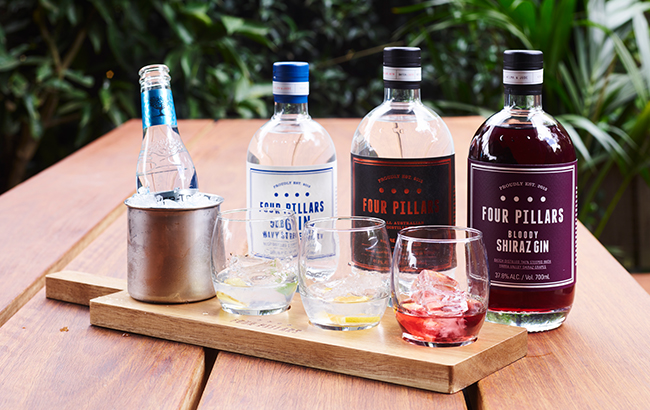How gin brands are preparing for the return of GTR
By Nicola CarruthersAs certain countries regain control over Covid-19, the global travel retail sector is examining how it can attract travellers when they start flying again. The Spirits Business explores how gin producers are preparing for the channel’s revival.

Gone are the days when only established brands dominated shelf space in airports, on airline trolleys and cruise ships. Today, there is a great deal of choice for shoppers in travel retail, making it a hugely competitive sector for spirits.
For gin, which continues to see a boom in markets such as the US, the global travel retail (GTR) channel offers producers the opportunity to target consumers looking to try unusual flavours, small batch brands and exclusive gins for at‐home cocktail making.
Data from IWSR Drinks Market Analysis shows that gin/genever volumes in GTR grew by a compound annual growth rate (CAGR) of 9.8% between 2014 and 2019. IWSR forecasts the gin category to post 1.7% CAGR volume from 2019 to 2024.
Ignacio Vázquez, global head of marketing for Bacardi Global Travel Retail, says: “The gin category is tremendously exciting, its growth in GTR is driven by premium innovation, with a third of growth in the category coming from flavoured gins. IWSR 2019 reported gin growth of 11.2%. Premium‐plus is growing at 16.5% year on year in comparison with 5% growth in standard gin.”
The Covid‐19 pandemic has created one of the biggest challenges that GTR has ever faced, as restrictions on global travel have decimated the duty free industry.
Eamon Prunty, head of global travel retail for Whitley Neill gin owner Halewood Artisanal Spirits, believes the category will rebound quickly. He says: “Covid headwinds are unlikely to have had such a marked impact on gin, with the huge success it experienced before the pandemic helping the category bounce back faster than others in the channel.”
But Mark Lawton, regional trade and GTR director for Australian gin brand Four Pillars, believes it could take up to four years for the category to return to 2019 levels. William Ovens, Ian Macleod Distillers’ business development director of travel retail, notes the growth of flavoured gins, which will be key to the firm’s strategy.
Ovens says: “Up until the Covid pandemic, gin was showing continued growth, particularly in the full‐strength flavoured category. The growth of gin domestically is still driven by the full‐ strength flavoured category, so we are placing additional focus on this area of our portfolio. Local/regional gins have also been performing well in recent years; that’s a subcategory Edinburgh Gin plays well in.”
Vázquez believes flavoured gin is showing “explosive growth” in the channel. Bacardi is hoping to tap into the trend of at‐home cocktail making with its new Bombay Bramble gin in GTR, which combines the brand’s gin with a ‘real’ fruit infusion. “The new, post‐ pandemic gin shopper is looking for excitement, inspiration and innovation for home cocktail making,” says Vázquez. “In the UK domestic market, 42% of Bombay Bramble shoppers are new to flavoured gin, and we are confident it will drive incremental category growth in global travel too.”
Vázquez outlines three ways to attract consumers in the channel. He says: “GTR exclusives; fulfilling the growing demand for personalisation; and insight‐driven brand innovation are three important keys to success in trading consumers up, driving basket spend and to make the most of the impulse opportunity in GTR.”
While Lawton notes there is a “growing interest in different flavours”, he believes consumers will return to the “mother brand” once travel returns, rather than line extensions. Four Pillars’ strategy for the channel over the next two years will be to focus on its four main SKUs, and support its partners in the channel. Lawton believes a “category approach” is needed for the market: “Retailers need to talk about gin as a category rather than as a single brand.”

Four Pillars’ priority will be on the markets it currently operates in – Australia, New Zealand, Singapore, Hong Kong and Dubai. The Australian gin has a campaign planned for its home market to “help the craft industry get back on its feet” and support the smaller brands. GTR is a “long‐term” channel for Four Pillars, which is looking to eventually expand into markets such as the Middle East, UK and US.
Edinburgh Gin has big plans for the channel in 2021, if passenger numbers return, and will roll out an expanded range of full‐strength flavoured gins in travel retail, with a focus on its Rhubarb and Ginger gin. Edinburgh Gin Classic will also return to the channel from April 2021 onwards.
The brand also plans to roll out its Filled with Wonder marketing campaign, which debuted in travel retail, with bespoke permanent wall bays in Edinburgh Airport in November 2020, followed by London Stansted Airport.
EXCITING ACTIVATIONS
Ovens adds: “We also have some very exciting activations to roll out, but will only do so if we see a positive return in passenger numbers in the second half of the year.” He notes there is “still lots of opportunity to expand Edinburgh Gin’s international distribution and footprint”.
Once consumers travel again, Lawton predicts a “step change”, with them adapting to different shopping environments. He also says retailers “must move away from deep discounting” and focus on added service and experience, while online shopping before arriving at the airport will be key.
For Bacardi, digital will be crucial to the brand’s strategy in the channel. “We are ready to optimise the ‘connected travel experience’,” says Vázquez. “We see it as the biggest transformational opportunity in the history of the channel. There is exponential growth in digital adoption, with 38% of travellers willing to shop online, according to research carried out last year by M1nd‐set, and with many new opportunities to enhance the omni‐channel travel experience. We are also planning insight‐driven strategies that improve conversion through value propositions and create loyalty to ensure repeat purchase.”
Prunty adds: “GTR is a lot about touch, feel and sampling – even after we start coming out of the pandemic, it’s unlikely this approach will continue as shopping habits will have changed. To mitigate the effects of this, for everybody in the sector (not just in gin), the development of online platforms will be essential – they will become one of the most effective media methods through which to influence consumer shopping habits.”
Shelf space has always been an issue in the GTR channel, with the pandemic further intensifying the issue as retailers prioritise the best‐selling brands. Lawton says one of the biggest challenges for travel retail is the growing prevalence of major brands: “The bigger brands will get bigger. Smaller craft brands won’t get that opportunity as they don’t have the investment. I’m sure there will be consolidation of retailers too.”
Vázquez is optimistic about the future of GTR: “I believe this new era has created so many advantages in travel retail for us all to recruit more consumers. We can talk to them early in their travel planning, optimise digital selling opportunities, and we can create new experiences in physical retail to leverage GTR’s core strength as a unique brand‐ building channel. Bacardi is committed to travel retail for the long term; it will always be a fantastic showroom for our portfolio.”
